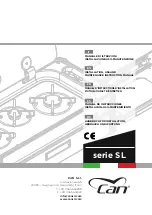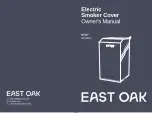
47
BETTY THERMO
cod.
395100020
- 12/2010
47/60
GB
D
7.4 FITTING THE SMOKE VALVE (OPTIONAL)
The valve (smoke valve) does not need to be screw-
fixed. It should simply be inserted in the cast iron
smoke outlet collar.
Insert the valve as shown in figures 7.4.1.1, 7.4.1.2.
It is advisable to seal (
S
) - using high temperature
silicone - the valve against the cast iron collar at the
point indicated in fig. 7.4.1.1.
Use handle (
M,
fig. 7.4.1.3) to open or close the valve
to optimise the smoke draught (
A
: open;
C
: closed).
8 MAINTENANCE AND CLEANING
8.1 SAFETY PRECAUTIONS
Prior to embarking on any maintenance work the
following precautions must be taken:
A) make sure all parts of the cooker are cold.
B) make sure the ashes are completely cold and not
burning.
C) use the individual protective gear as established
by the EEC directive 89/391.
D) always use the most appropriate maintenance
tools.
Once the winter has come to an end, the cooker should
be cleaned completely and all ash and soot removed.
The water should only be drained if repair work is
necessary. If the system is not used in winter, it is
advisable to introduce some antifreeze in the system;
or if the heater-cooker is not used for a prolonged
period of time, we recommend you drain all its circuits
completely to avoid any water contained from freezing.
8.2 GETTING RID OF THE ASHES
The ash drawer, which is under the hearth (Fig. 3.1.1
component 12), must be completely emptied when it
is full so as not to overheat the hearth’s cast iron grid
preventing the comburent air from reaching it.
The drawer should be emptied frequently to facilitate
regular inlet of comburent air into the fireplace. The
drawer should be emptied when the cooker is cold,
for example every morning before lighting.
8.3 CLEANING THE HEART
At regular intervals or when soot deposits become
too bad, clean the hearth thorough. This enables a
better functioning and yield of the cooker.
8.4 CLEANING THE FLUE
This is to be done before lighting the cooker and each
time a layer of soot or tar is noted inside the pipe, as
this is an easily inflammable substance.
When the deposits are 5-6 mm thick they could catch
fire if the temperature is very high and if there are
sparks, damaging the flue and the house. At any rate,
clean at least once a year.
Während des Normalbetriebs des Herdes
sollte das
Ventil niemals vollständig geöffnet
werden. Dadurch
erhält man stets eine gute Leistung und verhindert,
dass der größte Teil der Verbrennungswärme über
die Rauchgase verloren geht .
7.4 RAUCHREGLERVENTILANORDNUNG
(OPTIONAL)
Das Ventil (Rauchreglerventil) muss nicht mit
Schrauben befestigt werden, es wird einfach in den
gusseisernen Kragen des Rauchgasaustritts
gesteckt.
Das Ventil wie in den Abb. gezeigt einstecken. 7.4.1.1,
7.4.1.2.
Das Ventil sollte am gusseisernen Kragen (
S
), an der
in der Abb. 7.4.1.1 gezeigten Stelle mit Spezialsilikon
für hohe Temperaturen abgedichtet werden.
Mit dem Griff (
M,
Abb. 7.4.1.3) kann man für einen
optimalen Rauchgasabzug das Ventil öffnen oder
schließen (
A
: offen;
C
: geschlossen).
8 INSTANDHALTUNG UND REINIGUNG
8.1 VORBEUGENDE SICHERHEITSMASSNAHMEN
Vor jedem Wartungseingriff unbedingt folgende
Sicherheitsmaßnahmen treffen:
A) Sicherstellen, dass alle Heizofenteile kalt sind.
B) Sicherstellen, dass die Asche komplett erloschen ist.
C) Die laut Richtlinie 89/391/EWG vorgesehenen
individuellen Schutzvorrichtungen anwenden.
D) Für die Wartung immer geeignetes Werkzeug
verwenden.
Nach der Wintersaison muss der Herd gründlich von
Asche und Russ befreit werden. Das Wasser muss
nur abgelassen werden, wenn Reparaturen
durchzuführen sind. Falls das System im Winter nicht
benutzt wird, sollte der Anlage ein Frostschutzmittel
beigegeben werden. Falls der Heizherd für längere
Zeit nicht benutzt wird, empfiehlt es sich alle Kreisläufe
vollständig zu leeren, damit das in ihnen enthaltene
Wasser nicht einfriert.
8.2 ASCHENENTLEERUNG
Der Aschenkasten, der sich unterhalb der Feuerstelle
befindet (Abb. 3.1.1 Bauteil 12), muss vor jedem
Zünden und jedes Mal, wenn er voll ist, entleert werden,
damit das Gusseisengitter nicht überhitzt und keine
Verbrennungsluft in die Feuerstelle eintreten kann. Um
Zugang zum Aschenkasten zu kommen, die Tür öffnen.
Es wird in jedem Fall empfohlen, den Aschenkasten
häufig zu entleeren, um eine reguläre Zufuhr der
Verbrennungsluft in die Feuerstelle zu fördern. Es ist
ratsam, den Herd zuvor abkühlen zu lassen und diesen
in jedem Fall täglich vor dem Zünden zu entleeren.
8.3 REINIGUNG DER FEUERSTELLE
Die Feuerstelle von Zeit zu Zeit und immer dann, wenn
Содержание ALBA IDRO
Страница 2: ......
Страница 7: ...7 BETTY THERMO cod 395100020 12 2010 7 60 ...














































